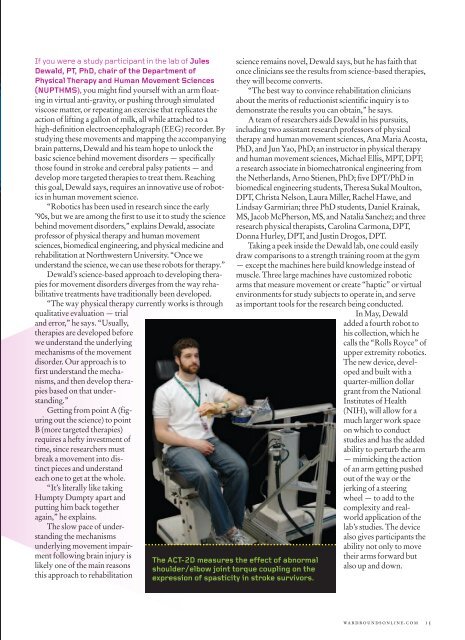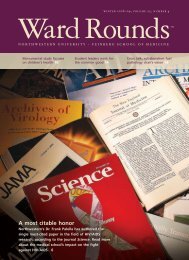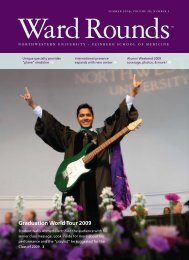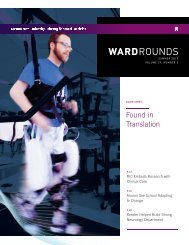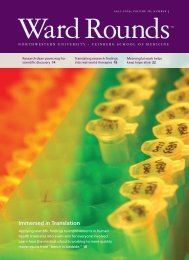Download PDF - Ward Rounds - Northwestern University
Download PDF - Ward Rounds - Northwestern University
Download PDF - Ward Rounds - Northwestern University
Create successful ePaper yourself
Turn your PDF publications into a flip-book with our unique Google optimized e-Paper software.
If you were a study participant in the lab of Jules<br />
Dewald, PT, PhD, chair of the Department of<br />
Physical Therapy and Human Movement Sciences<br />
(NUPTHMS), you might find yourself with an arm floating<br />
in virtual anti-gravity, or pushing through simulated<br />
viscose matter, or repeating an exercise that replicates the<br />
action of lifting a gallon of milk, all while attached to a<br />
high-definition electroencephalograph (EEG) recorder. By<br />
studying these movements and mapping the accompanying<br />
brain patterns, Dewald and his team hope to unlock the<br />
basic science behind movement disorders — specifically<br />
those found in stroke and cerebral palsy patients — and<br />
develop more targeted therapies to treat them. Reaching<br />
this goal, Dewald says, requires an innovative use of robotics<br />
in human movement science.<br />
“Robotics has been used in research since the early<br />
’90s, but we are among the first to use it to study the science<br />
behind movement disorders,” explains Dewald, associate<br />
professor of physical therapy and human movement<br />
sciences, biomedical engineering, and physical medicine and<br />
rehabilitation at <strong>Northwestern</strong> <strong>University</strong>. “Once we<br />
understand the science, we can use these robots for therapy.”<br />
Dewald’s science-based approach to developing therapies<br />
for movement disorders diverges from the way rehabilitative<br />
treatments have traditionally been developed.<br />
“The way physical therapy currently works is through<br />
qualitative evaluation — trial<br />
and error,” he says. “Usually,<br />
therapies are developed before<br />
we understand the underlying<br />
mechanisms of the movement<br />
disorder. Our approach is to<br />
first understand the mechanisms,<br />
and then develop therapies<br />
based on that under -<br />
standing.”<br />
Getting from point A (figuring<br />
out the science) to point<br />
B (more targeted therapies)<br />
requires a hefty investment of<br />
time, since researchers must<br />
break a movement into distinct<br />
pieces and understand<br />
each one to get at the whole.<br />
“It’s literally like taking<br />
Humpty Dumpty apart and<br />
putting him back together<br />
again,” he explains.<br />
The slow pace of understanding<br />
the mechanisms<br />
underlying movement impairment<br />
following brain injury is<br />
likely one of the main reasons<br />
this approach to rehabilitation<br />
science remains novel, Dewald says, but he has faith that<br />
once clinicians see the results from science-based therapies,<br />
they will become converts.<br />
“The best way to convince rehabilitation clinicians<br />
about the merits of reductionist scientific inquiry is to<br />
demonstrate the results you can obtain,” he says.<br />
A team of researchers aids Dewald in his pursuits,<br />
including two assistant research professors of physical<br />
therapy and human movement sciences, Ana Maria Acosta,<br />
PhD, and Jun Yao, PhD; an instructor in physical therapy<br />
and human movement sciences, Michael Ellis, MPT, DPT;<br />
a research associate in biomechatronical engineering from<br />
the Netherlands, Arno Stienen, PhD; five DPT/PhD in<br />
biomedical engineering students, Theresa Sukal Moulton,<br />
DPT, Christa Nelson, Laura Miller, Rachel Hawe, and<br />
Lindsay Garmirian; three PhD students, Daniel Krainak,<br />
MS, Jacob McPherson, MS, and Natalia Sanchez; and three<br />
research physical therapists, Carolina Carmona, DPT,<br />
Donna Hurley, DPT, and Justin Drogos, DPT.<br />
Taking a peek inside the Dewald lab, one could easily<br />
draw comparisons to a strength training room at the gym<br />
— except the machines here build knowledge instead of<br />
muscle. Three large machines have customized robotic<br />
arms that measure movement or create “haptic” or virtual<br />
environments for study subjects to operate in, and serve<br />
as important tools for the research being conducted.<br />
In May, Dewald<br />
added a fourth robot to<br />
his collection, which he<br />
calls the “Rolls Royce” of<br />
upper extremity robotics.<br />
The new device, developed<br />
and built with a<br />
quarter-million dollar<br />
grant from the National<br />
Institutes of Health<br />
(NIH), will allow for a<br />
much larger work space<br />
on which to conduct<br />
studies and has the added<br />
ability to perturb the arm<br />
— mimicking the action<br />
of an arm getting pushed<br />
out of the way or the<br />
jerking of a steering<br />
wheel — to add to the<br />
complexity and realworld<br />
application of the<br />
lab’s studies. The device<br />
also gives participants the<br />
ability not only to move<br />
The ACT-2D measures the effect of abnormal<br />
shoulder/elbow joint torque coupling on the<br />
expression of spasticity in stroke survivors.<br />
their arms forward but<br />
also up and down.<br />
wardroundsonline.com 15


